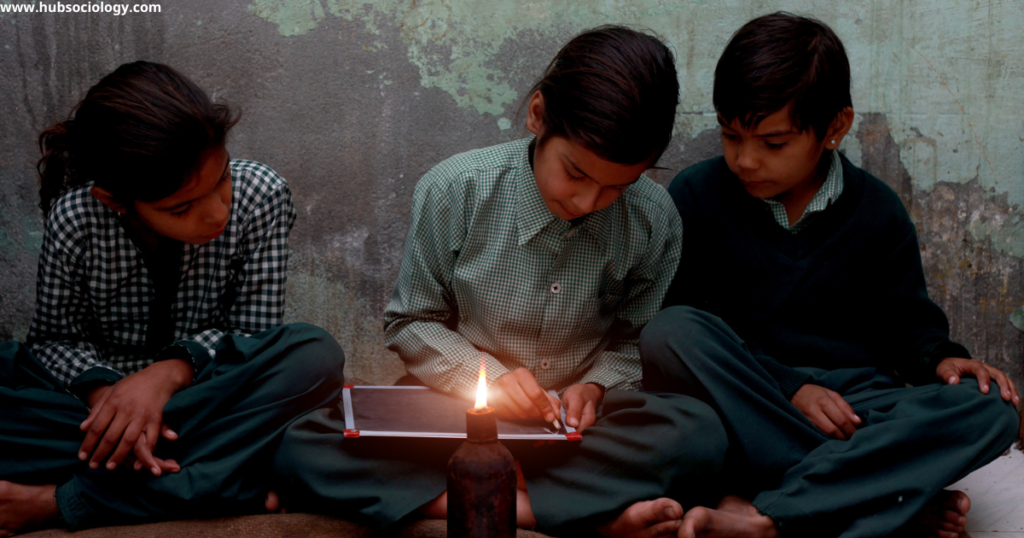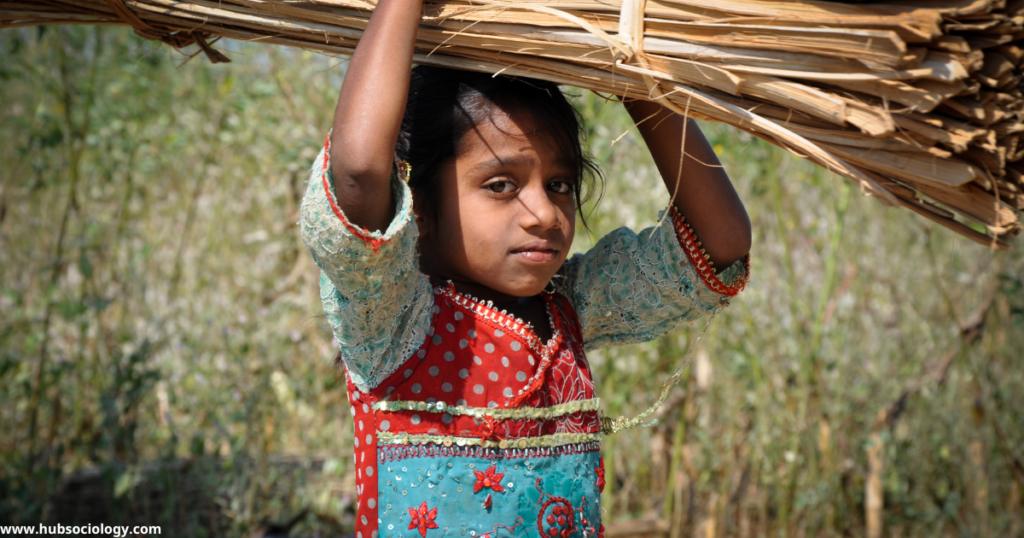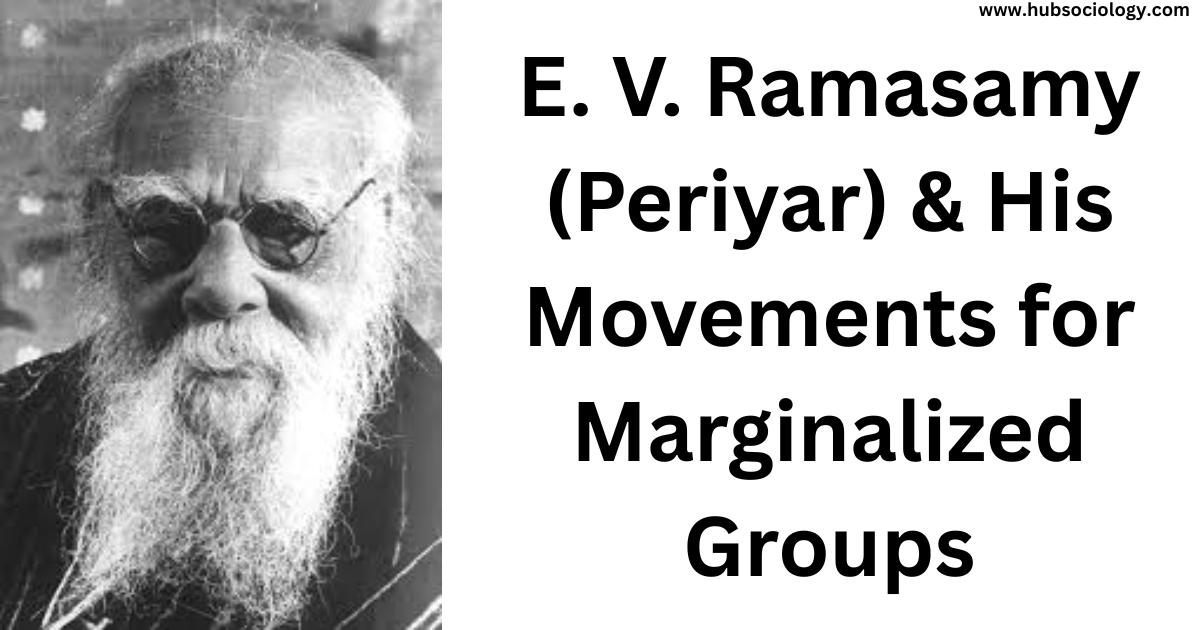Introduction

Erode Venkatappa Ramasamy, popularly known as Periyar (meaning “The Great One”), was a social reformer, rationalist, and political activist who championed the rights of marginalized communities in India. His ideologies and movements were deeply rooted in anti-caste, anti-religious orthodoxy, and social justice principles. From a sociological perspective, Periyar’s work provides critical insights into the dynamics of caste oppression, gender inequality, and social exclusion in Indian society. His Self-Respect Movement and Dravidian ideology challenged Brahminical hegemony and sought to empower oppressed groups, including Dalits, women, and lower-caste communities.
This article examines Periyar’s contributions to social reform, his ideological foundations, and the lasting impact of his movements on marginalized groups in India. It also explores the relevance of his ideas in contemporary sociological debates on caste, gender, and social justice.
Historical and Social Context of Periyar’s Movement
Periyar’s activism emerged in early 20th-century Tamil Nadu, a region deeply entrenched in the caste hierarchy. The Brahminical social order dominated political, economic, and cultural spheres, while Shudras and Dalits faced systemic oppression. The nationalist movement, led largely by upper-caste elites, often ignored caste-based injustices, reinforcing social inequalities.
Periyar, initially a Congress leader, grew disillusioned with the party’s indifference to caste oppression. His experiences, including witnessing the exclusion of non-Brahmins from temples and public spaces, radicalized him. He broke away from the Indian National Congress and dedicated his life to dismantling caste hierarchies and promoting rationalism.
Key Movements and Ideologies
1. The Self-Respect Movement (1925)
The Self-Respect Movement was Periyar’s most significant contribution to social reform. It emphasized:
- Dignity and Equality: The movement sought to instill self-respect among oppressed castes by rejecting Brahminical superiority.
- Rationalism and Atheism: Periyar criticized religious dogma, arguing that scriptures like the Manusmriti legitimized caste oppression.
- Anti-Caste Struggles: The movement opposed untouchability and promoted inter-caste marriages to dismantle caste barriers.
Sociologically, the Self-Respect Movement can be seen as a counter-hegemonic struggle against the dominant caste order. It empowered lower castes to assert their rights and reject subjugation.
2. Anti-Brahminism and Dravidian Identity
Periyar argued that Brahmins monopolized power through religious and cultural dominance. His anti-Brahminism was not hatred towards individuals but a critique of institutionalized caste privilege. He propagated the idea of a Dravidian identity, asserting that South Indians were ethnically and culturally distinct from North Indian Brahminical traditions.
This ideology laid the foundation for the Dravidar Kazhagam (DK) and later the Dravida Munnetra Kazhagam (DMK), which played a crucial role in Tamil Nadu politics. The emphasis on Dravidian pride was instrumental in mobilizing non-Brahmin communities against caste oppression.
3. Women’s Rights and Gender Equality
Periyar was a staunch advocate of women’s rights, challenging patriarchal norms embedded in Hindu traditions. His contributions include:
- Opposition to Child Marriage and Dowry: He campaigned against regressive practices that exploited women.
- Women’s Education and Employment: Periyar believed that economic independence was key to women’s liberation.
- Critique of Religious Patriarchy: He condemned religious texts that justified women’s subordination.
From a feminist sociological perspective, Periyar’s work was ahead of its time, addressing both caste and gender oppression intersectionally.
4. Social Justice and Reservation Policies
Periyar was a strong proponent of affirmative action. He argued that historical injustices against lower castes necessitated compensatory discrimination. His advocacy influenced the implementation of reservation policies in Tamil Nadu, ensuring representation for marginalized groups in education and employment.
Sociological Analysis of Periyar’s Impact

1. Challenge to Caste Hegemony
Periyar’s movements disrupted the traditional caste structure by:
- Deconstructing Religious Justifications: By attacking sacred texts, he exposed how religion sustained caste hierarchies.
- Political Mobilization: His efforts led to the rise of non-Brahmin leadership in Tamil Nadu, altering power dynamics.
2. Empowerment of Marginalized Groups
The Self-Respect Movement fostered a sense of agency among Dalits and lower castes. It encouraged:
- Assertion of Rights: Marginalized groups began demanding equal treatment in temples, schools, and public spaces.
- Cultural Renaissance: Tamil language and Dravidian culture were celebrated as alternatives to Sanskritized traditions.
3. Influence on Modern Social Movements
Periyar’s ideas resonate in contemporary movements such as:
- Dalit activism (e.g., Bhim Army, Ambedkarite movements)
- Feminist struggles against caste-patriarchy
- Anti-caste discourse in academia and politics
Criticisms and Controversies
Despite his contributions, Periyar faced criticism:
- Excessive Anti-Brahmin Rhetoric: Some argue that his movement alienated Brahmins rather than fostering caste harmony.
- Limited Pan-India Influence: His movement remained largely confined to Tamil Nadu.
- Political Co-optation: Later Dravidian parties diluted his radical ideals for electoral gains.
Conclusion: Periyar’s Legacy in Sociology
Periyar’s movements provide a framework for understanding caste, gender, and social justice in India. His emphasis on rationalism, self-respect, and anti-caste struggles remains relevant in contemporary sociology. While his methods were radical, they were necessary to challenge deeply entrenched inequalities.
For sociology students, studying Periyar offers insights into:
- Social Stratification and Power Dynamics
- Intersectionality of Caste and Gender
- Role of Social Movements in Structural Change
Periyar’s legacy endures as a beacon of resistance against oppression, inspiring future generations to fight for an equitable society.

Topic Related Questions
5-Mark Questions (Short Answer Type)
- Who was E. V. Ramasamy (Periyar)? Briefly explain his role in social reform.
- What was the Self-Respect Movement? Explain its main objectives.
- How did Periyar challenge Brahminical dominance?
- What were Periyar’s views on women’s rights?
- Define “Dravidian identity” in Periyar’s ideology.
- Why did Periyar oppose religious scriptures like the Manusmriti?
- What was Periyar’s stance on caste-based reservation?
- How did Periyar contribute to the upliftment of Dalits?
- What was the role of the Dravidar Kazhagam (DK) in social reform?
- How did Periyar promote rationalism in society?
- What was Periyar’s view on Hinduism and its role in caste oppression?
- How did Periyar’s movement influence Tamil Nadu’s politics?
- Explain Periyar’s concept of “self-respect marriages.”
- What was Periyar’s stance on Hindi imposition?
- How did Periyar use media (newspapers, speeches) to spread his ideology?
- What were Periyar’s contributions to Tamil language revival?
- Why did Periyar oppose the Indian National Congress?
- What role did Periyar play in the Temple Entry Movement?
- How did Periyar’s ideas differ from Gandhi’s on caste reform?
- What was Periyar’s critique of superstition and blind faith?
10-Mark Questions (Detailed Answer Type)
- Discuss the significance of the Self-Respect Movement in challenging caste hierarchies.
- Analyze Periyar’s critique of Brahminical Hinduism and its impact on social reform.
- Examine Periyar’s contributions to women’s empowerment in Tamil Nadu.
- How did Periyar’s anti-caste ideology influence the Dravidian political movement?
- Evaluate the role of Periyar in promoting social justice for marginalized communities.
- Compare Periyar’s and Ambedkar’s approaches to fighting caste oppression.
- Explain the concept of “rationalism” in Periyar’s ideology with examples.
- How did Periyar’s movement contribute to the cultural assertion of non-Brahmin communities?
- Discuss the impact of Periyar’s ideas on contemporary Dalit and feminist movements.
- Why did Periyar advocate for inter-caste marriages? Explain its social significance.
- Discuss Periyar’s role in the anti-Hindi agitation and its impact on Dravidian identity.
- Analyze how Periyar’s Self-Respect Movement promoted atheism and rationalism.
- Examine Periyar’s influence on the formation of the DMK and its political ideology.
- How did Periyar’s movement challenge patriarchy in Tamil society?
- Compare Periyar’s and Marx’s views on religion as a tool of oppression.
- Explain Periyar’s advocacy for social justice in education and employment.
- Discuss the impact of Periyar’s ideas on contemporary anti-caste movements.
- How did Periyar’s movement contribute to the decline of Brahmin dominance in Tamil Nadu?
- Evaluate Periyar’s role in the upliftment of Adi Dravidas (Dalits).
- Why did Periyar oppose the Varnashrama Dharma system?
15-Mark Questions (Essay-Type/Long Answer)
- Critically analyze Periyar’s role as a social reformer in the empowerment of marginalized groups in India.
- Discuss the sociological significance of Periyar’s Self-Respect Movement in the context of caste and gender struggles.
- Examine how Periyar’s Dravidian ideology challenged the traditional caste system and Brahminical hegemony.
- “Periyar was not just a social reformer but also a radical revolutionary.” Justify this statement with reference to his movements.
- Assess the impact of Periyar’s anti-caste and rationalist movements on modern Indian society.
- How did Periyar’s ideas on social justice influence affirmative action policies in Tamil Nadu?
- Compare and contrast Periyar’s and Jyotirao Phule’s contributions to anti-caste movements in India.
- “Periyar’s feminism was intersectional, addressing both caste and gender oppression.” Discuss.
- Analyze the criticisms and limitations of Periyar’s social reform movements.
- Evaluate the relevance of Periyar’s ideologies in contemporary debates on caste, religion, and social justice.
- “Periyar’s Self-Respect Movement was a radical challenge to the caste system.” Critically analyze this statement.
- Discuss how Periyar’s ideology of social justice influenced Tamil Nadu’s reservation policies.
- Examine the role of Periyar’s Dravidar Kazhagam in shaping anti-Brahmin politics in South India.
- “Periyar’s feminism was ahead of its time.” Discuss with reference to his reforms for women’s rights.
- How did Periyar’s rationalist movement contribute to scientific temper in Tamil society?
- Critically evaluate Periyar’s impact on the democratization of Tamil Nadu’s social and political landscape.
- Compare Periyar’s and Ambedkar’s strategies for Dalit empowerment.
- “Periyar’s movement was not just anti-caste but also anti-nationalist.” Discuss.
- Analyze the limitations of Periyar’s movement in achieving complete social equality.
- “Periyar’s legacy continues to shape modern Tamil identity.” Critically examine this statement.
Bonus: Applied Sociology Questions (Case Study-Based)
- If Periyar were alive today, how would he respond to the rise of Hindutva politics? (10 marks)
- A Dalit student faces discrimination in a Tamil Nadu college. How would Periyar’s ideology guide their resistance? (5 marks)
- Case Study: A village in Tamil Nadu still practices untouchability. Suggest Periyar-inspired solutions to eradicate it. (15 marks)
